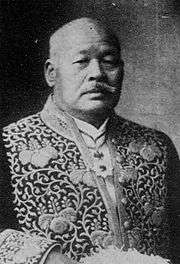Noda Utarō
Noda Utarō (野田 卯太郎, 21 December 1853 – 23 February 1927) was an entrepreneur, politician and cabinet minister in the pre-war Empire of Japan.
Noda Utarō 野田 卯太郎 | |
|---|---|
 Noda Utarō | |
| Born | December 21, 1853 Takata, Fukuoka, Japan |
| Died | February 23, 1927 (aged 73) |
| Nationality | Japanese |
| Occupation | politician, cabinet minister |
Biography
Noda was from a wealthy farming family of Takata, Fukuoka (currently part of the city of Miyama, Fukuoka Prefecture). In his youth, he worked in the Miike Coal Mines, following which he obtained a position at the Miike Bank, both owned by the Mitsui zaibatsu. He became active in politics, supporting the Freedom and People's Rights Movement, serving in the Fukuoka Prefectural Assembly in 1886. He was elected to the Lower House of the Diet of Japan in the March 1898 General Election, and was subsequently re-elected a total of nine times. As an entrepreneur, he founded the Miike Civil Engineering Company, and was one of the founding members of the South Manchurian Railway in 1906. He was secretary-general of the Rikken Seiyūkai political party in 1912, and became vice president of the Oriental Development Company in 1913. While vice president of the Oriental Development Company, Noda advised the Diet that the number of Japanese agricultural emigrants to Korea would reach 500,000 by the year 1920, however, the actual numbers eventually turned out to be only a small fraction of this number.[1]
Noda served as Minister of Communications from 1918-1922 under the Hara and Takahashi administrations. He subsequently served as Minister of Commerce and Industry under the Katō Tomosaburō administration in 1925.
Noda was also a poet, noted for the nationalistic themes in his works, and was a close correspondent with Tōyama Mitsuru and Nakano Seigō, with whom he cooperated in the creation of the Kokushikan University in 1917.
References
- Roberts, John G (2008). Mitsui: three centuries of Japanese business. University of California Press. ISBN 0-8348-0080-2.
- Storry, Richard (1957). The double patriots: a study of Japanese nationalism. Greenwood Press. ISBN 0-8371-6643-8.
External links
| Wikimedia Commons has media related to Utarō Noda. |
Notes
- Duss, Peter (1995). The Abacus and the Sword: The Japanese Penetration of Korea, 1895-1910. University of California Press. ISBN 0520920902. page 307-311
| Political offices | ||
|---|---|---|
| Preceded by Takahashi Korekiyo |
Minister of Commerce and Industry Apr 1925 – Aug 1925 |
Succeeded by Kataoka Naoharu |
| Preceded by Den Kenjirō |
Minister of Communications Sept 1918 – June 1922 |
Succeeded by Maeda Toshisada |